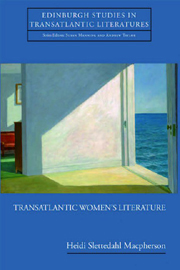Book contents
- Frontmatter
- Contents
- Acknowledgements
- Introduction: ‘No Region for Tourists and Women’
- Part 1: The Exoticised Other
- Introduction
- 1 Constructing Race across the Atlantic: Nella Larsen's Quicksand
- 2 Assimilation in the (Fictional) Heartland: Bharati Mukherjee's Jasmine
- Part 2: Memoirs and Transatlantic Travel
- Part 3: Negotiating the Foreign/Re-Inventing Home
- Conclusion
- Bibliography
- Index
2 - Assimilation in the (Fictional) Heartland: Bharati Mukherjee's Jasmine
from Part 1: The Exoticised Other
Published online by Cambridge University Press: 12 September 2012
- Frontmatter
- Contents
- Acknowledgements
- Introduction: ‘No Region for Tourists and Women’
- Part 1: The Exoticised Other
- Introduction
- 1 Constructing Race across the Atlantic: Nella Larsen's Quicksand
- 2 Assimilation in the (Fictional) Heartland: Bharati Mukherjee's Jasmine
- Part 2: Memoirs and Transatlantic Travel
- Part 3: Negotiating the Foreign/Re-Inventing Home
- Conclusion
- Bibliography
- Index
Summary
There are no harmless, compassionate ways to remake oneself. We murder who we were so we can rebirth ourselves in the images of dreams.
Bharati Mukherjee, Jasmine (1989)The above quotation from Bharati Mukherjee's Jasmine (1989) in many ways encapsulates the novel, especially in the way that it highlights both the violence of identity shifts and the mythical embrace of the American Dream, an embrace that Mukherjee deconstructs in the narrative of her peripatetic and eponymous heroine. Jasmine is the story of a young woman named, variously, Jyoti, Jasmine, Jazzy, Jase and Jane, who travels from India to the US on an ever-westward trek that finally sees her lighting out for the territory into an unknown future. In the novel, Mukherjee relies on familiar American myths and images, altering them strategically to acknowledge the impact of gender and ethnicity on transatlantic travel. As a result, Jasmine's encounters with ‘America’ – both mythic and real – affect her negotiations of her transatlantic, gendered identity.
In its archetypal configuration, the American Dream sites the solitary white male as the hero of the tale. Mukherjee's novel records the necessary alteration of the dream when its principal figure is an illegal female immigrant who both seeks and resists assimilation.
- Type
- Chapter
- Information
- Transatlantic Women's Literature , pp. 60 - 78Publisher: Edinburgh University PressPrint publication year: 2008



